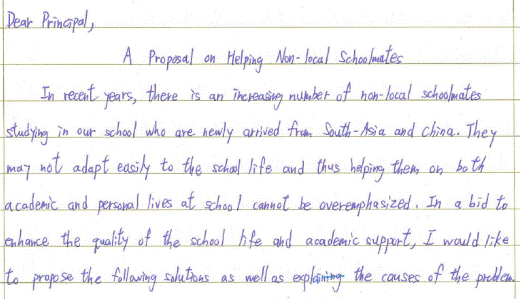| Background Feedback from teachers on the implementation of the NSS Elective Modules shows that, although students find the Electives interesting and motivating, there is limited time for implementing them in the classroom. For this reason, it is wise to combine the Elective Modules with training in core skills, especially for students approaching public examinations. At Heung To Middle School, teachers planned a module on “Learning English through Social Issues”, which focused on the development and practice of reading skills. Since there was too much material to implement all the units in the teaching time available, it was decided that the two units on “Problems and Solutions” would be differentiated, with one for less proficient and one for more able students. Teachers would therefore be able to choose one of the two units to use with their classes based on the students’ ability level. Analysis of students’ performance in the HKDSE practice papers and first “live” examination were used as a reference in deciding the reading skill focuses of the two units. |
| |
Objectives
- Expose students to material on a variety of social issues
- Promote vocabulary learning related to each issue
- Focus on reading and writing skills, which are identified as weaknesses.
- Cater for learner diversity
|
| |
Implementation
| 1. |
Issues covered in the module |
Based on observations of the writing questions set in Paper 2 of the HKDSE for the Elective Module “Learning English through Social Issues”, it was decided to include a variety of issues for study in the module, and to ask groups to present on different issues for the spoken assessment task. The purpose of doing so was to provide students with vocabulary and content from as wide a range of issues as possible.
Two assessment tasks were designed for the module:
| • |
A group presentation given in class |
| • |
A written task based on information in the presentations and done under exam conditions |
Students worked in groups to prepare a presentation on a social issue chosen from a list provided by teachers. Students had to cover the causes, effects and solutions of the issue in their presentation. While presentations were being given, students in the audience had to record key details and useful vocabulary on a graphic organiser designed for the purpose.
For the written task, questions were set based on a selection of the issues covered in the presentations. In order to simulate the conditions of the HKDSE Paper 2, a choice of questions was offered, and students had to complete the task under exam conditions.
| 3. |
Differentiation of the two units on “Problems and Solutions” |
| |
|
| |
Overall structure of the module |
| |
|
Part |
Issue |
Aspect |
Text types |
Writing |
| |
|
1 |
Various |
Defining a social issue |
• Definitions |
Definitions |
| |
|
2 |
Internet addiction |
Causes and effects |
• Documentary
• Article |
Review |
Differentiated units |
 |
3a |
Compensated dating |
Problems and solutions |
• Talk show
• Letter to the editor
• Video interview |
Informal letter |
| 3b |
Animal abuse |
• Article
• Pamphlet
• Short Story |
Assembly speech |
| |
|
4 |
Discrimination |
Views of different parties |
• Definitions
• Comments
• Information video |
Proposal |
| |
Targeting the needs of different learners in the two units |
| |
Unit 3A |
Unit 3B |
| Topic |
Compensated dating |
Animal abuse |
| Texts chosen |
- Common text types - article, letter, talk show
- Adapted texts - materials produced by other schools
|
- Academic style writing
- Fiction text (short story
- Authentic texts – articles from various websites
|
| Reading focuses |
- Inferring feelings and attitudes
- Language structures in context
|
- Connotative meanings of words
- Writer’s style and word choice
- Idiomatic language
|
| Writing focuses |
Task involves synthesising material from various sources |
Task focuses on style and awareness of audience in writing |
| Lessons |
Lesson activity |
1-4 |
Part 1: Defining Social Issues
- Students are given a set of pictures representing social issues and are asked to identify them.
- Students look at some definitions of social issues and identify which issue is being described.
- Students choose a social issue from those they have been given and complete a spider diagram.
- Students write a definition of their chosen social issue.
Part 1 Defining social issues.doc |
5-9 |
Part 2: Causes and effects of a social issue: Internet addiction
- Students complete a questionnaire. They discuss the issue of Internet addiction and whether they are addicted to the Internet themselves. They suggest causes and effects of Internet addiction.
- Students watch a short video documentary about Internet addiction in China and treatment of addicts. They identify the causes and effects mentioned in the video and complete a graphic organiser.
- Students read a short passage about what has happened since the video was made and identify the language used to express causes and effects.
- Writing task: students write a review of the documentary, giving their own opinions on the issues.
Part 2 Causes and Effects.doc
Link for short video
http://www.youtube.com/watch?v=sa0L9Bhhwmg&NR=1
|
10-14 |
Part 3a: Problems and Solutions: Compensated dating
- Students look at pictures related to the topic and express their opinions.
- They read the tapescript of a radio talk show on the topic of compensated dating and identify the opinions and attitudes of the people involved.
- They read a letter to the editor and analyse the organization of the writing. They also discuss the advantages and disadvantages of the solution suggested by the writer.
- They watch a role-play radio talk show and make notes with the help of questions in Part C.
- Students write a personal letter as the final product of this section.
Part 3a Problems and Solutions - compensated dating.doc
|
10-14 |
Part 3b: Problems and Solutions: Animal abuse
- Students watch a short video about animal abuse and brainstorm ideas on the topic.
- They read an article on animal police in Hong Kong. They identify emotive language in the article and also the main points of each paragraph.
- They read an article from a charity website about the importance of educating children to be kind to animals and identify adjectives with positive and negative connotations.
- They write an assembly speech informing students about animal abuse and what they can do to help.
Part 3b Problems and Solutions - Animal Abuse.doc
Link to RSPCA clip:
http://www.youtube.com/watch?v=PZLR-0mRSkM
|
15-19 |
Part 4: Views of different parties: Discrimination
- Students identify different types of discrimination and underline related vocabulary items in the text.
- Students discuss the causes of discrimination. They role-play different parties and discuss both sides of some current issues involving discrimination.
- Students watch a video about the Equal Opportunities Commission and answer questions about the ordinances.
- They read and analyse a sample proposal on the topic of bullying.
- They write a proposal to the Principal concerning discrimination against South Asian students.
Part 4 Different views.doc
|
20-21 |
Part 5: Final task
Students are invited to speak at a conference on “Social Issues affecting young people in Hong Kong”. They are given a social issue in their group, or they are given a choice.
Part 5 Assessment materials.doc |
22-24 |
Students give their presentations in groups. Other students have to take notes on the presentations using graphic organizers.
Assessment
- Teacher will assess the presentations given.
- A writing question dealing with one of the social issues included in the forum (ie student presentations) above.
Part 5 Assessment materials.doc |
Impact on students
1. Student evaluation
Students’ response in general was positive. The most positive response concerned vocabulary learning, with 92.4% agreeing that they had learned some useful vocabulary for talking about different social issues. Concerning the assessment part, 90.5% agreed that the task had helped them to develop information searching and presentation skills, and 88.4% agreed that the materials in the unit and the final presentations helped them to prepare for the final task.
In comments, students appreciated the variety of media used, especially the videos. Some mentioned that the vocabulary was useful, though some requested more. Some students also mentioned that they would like more time to practise oral skills through group discussion, but there was insufficient time for that in lessons. In future, teachers could consider allowing more time for discussion, so that students can apply the vocabulary taught and thereby consolidate their learning.
2. Samples of students’ work: awareness of audience and style
Sample 1 |
The student has a good grasp of the audience and purpose of the writing. The choice of solutions given later is relevant to the school situation |
Sample 2
This student attempts an informal style in a letter to a Japanese penfriend. However, (s)he struggles to introduce the topic in a smooth and natural way |
 |
Sample 3 |
This student is able to introduce the topic of compensated dating in a more natural way, while keeping the informal style
|
Sample 4
This student gives relevant advice in an assembly speech for junior form students |
 |
Additional Files for download
Clip art licensed from the Clip Art Gallery on DiscoverySchool.com |
| |
Acknowledgements
Panel Chairperson: Ms Law Mei Han
Project coordinator: Mr Leung Ka Hung
Ms Wong Wai Yin
Ms Ng Yuen Fun
Ms Leung Ka Yin
Ms Lee Siu Yuk
Ms Law Man Ting
Mr. Poon Kwok Leung
|
|



